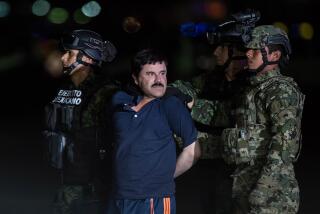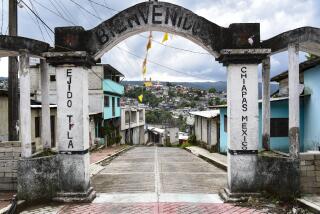Guatemala Sees Organized Crime as Security Threat
- Share via
GUATEMALA CITY — Powerful organizations that already control smuggling, auto theft and arms trafficking in Central America are using those established networks to transport illegal drugs, U.S. and regional officials warn.
The infusion of drug money is allowing criminal enterprises to become a force that can threaten national security, worrying military and church officials as well as government authorities.
“Our Central America has become a corridor for drugs, guns and [stolen] religious art,” said Bishop Mario Rios Montt, director of the Archdiocese Office on Human Rights in this capital. Criminal organizations that control this illegal trade are becoming the major threat to human rights in a region that has barely left behind brutal military regimes, he said.
Here in Guatemala, officials warn that narcotics traffickers aligned with local organized crime are turning the country into a virtual warehouse for Colombian cocaine bound for the United States and Europe.
Five years ago, the U.S. Drug Enforcement Administration estimated that 50 tons of cocaine passed through Guatemala each year. Now, some anti-narcotics officials believe, that quantity has quadrupled.
“Cocaine transshipment through Guatemala is expected to continue to increase, with no letup projected in the foreseeable future,” predicted the most recent U.S. State Department report on international anti-drug efforts.
Drug profits have strengthened organized crime to the point that smugglers are ready to engage in combat with authorities, officials said.
Early this year, a tractor-trailer rig headed to western Guatemala from the Caribbean port of Puerto Barrios, an established narcotics transshipment hub, drove through a customs roadblock. When customs officials pursued the truck, the driver first tried to run them off the road.
Then the rig stopped and several men scrambled out, submachine guns drawn. The outgunned customs officials gave up the pursuit.
“That truck was not carrying cookies,” Defense Minister Brig. Gen. Juan de Dios Estrada said during a recent interview.
Also this year, a car thief stole a Guatemalan army vehicle and killed the officer who was driving it.
Estrada has become so concerned about the threat from organized crime that he is working with customs officials, police and private businesses to try to fight smugglers, one of the most visible arms of the networks. That is a significant change in position for the armed forces, whose members themselves have previously been accused of links to criminal networks.
Four years ago, former Gen. Cesar Augusto Garcia Gonzalez was fired as vice minister of defense amid accusations that he was involved in a smuggling and robbery ring allegedly run by Alfredo Moreno Molina, a former military intelligence officer. Sixteen others, including three colonels, police officers, and customs officials also were dismissed in connection with the ring.
For the last six months, soldiers have been assigned to provide customs officials with security at mobile roadblocks when help is requested by civilian authorities. Often, authorities act on tips from business owners who have noticed suspicious movements.
So far, the operations have uncovered smuggled goods that evaded $461 million in import taxes, an aide to Estrada said. They have found no illegal drugs.
Still, Estrada said, “there is a relationship between smuggling and narcotics trafficking. We are making it less feasible to move narcotics overland.”
While American drug enforcement efforts focus on sea routes for illegal shipments, U.S. Customs Service officials have worked to organize their foreign counterparts into multi-agency, anti-narcotics task forces similar to the nascent effort in Guatemala.
Edward Moriarty, who runs the project for U.S. Customs, says drug traffickers are looking for ways to smuggle relatively small amounts of narcotics with minimal risk of getting caught.
Officials in Costa Rica, long considered a model of stability and safety in Central America, are concerned enough about the problem that they have joined six other Latin American countries in the U.S.-sponsored program to detect smuggled goods, including illegal drugs, in legitimate shipments. In the last five years, the program has recovered 240,000 pounds of illegal drugs, about half of them cocaine, Moriarty said.
Central Americans are equally concerned with the implications of organized crime networks that stretch beyond illegal drugs.
“These are not just little groups without capabilities or means,” Rios Montt said. In the days before Christmas, criminals broke into the cathedral in Guatemala City and another downtown church, stealing a silver statue of Christ, a silver facade for an altar and a jeweled Eucharist holder more than 3 feet tall.
The thieves needed both the means to move such large, heavy objects and a market for them, Rios Montt said.
Military intelligence indicates that criminal organizations operating in Guatemala are part of networks that have international ties, Estrada said.
Further, sources close to the investigation--who are prohibited from public comment--now believe that the unsolved 1998 slaying of Rios Montt’s predecessor, Juan Jose Gerardi, was an act of organized crime.
“Clearly, there were masterminds and someone else who carried out the murder,” Rios Montt said.
“Crime has invaded all levels of society,” he said, “to the point that we are coming to a real destruction of rights. All rights are violated with impunity.”
After decades of disagreeing on human rights issues during the 35-year civil war that ended in 1996, Guatemalan church and military officials have found common ground in their concern about organized crime. In Estrada’s estimation, criminal organizations flush with drug money have become a threat to national security.
“The lack of control makes us vulnerable,” he said. However, he noted: “We are still in time to bring this under control.”
More to Read
Sign up for Essential California
The most important California stories and recommendations in your inbox every morning.
You may occasionally receive promotional content from the Los Angeles Times.










